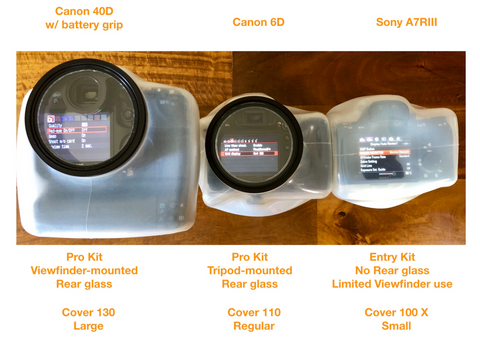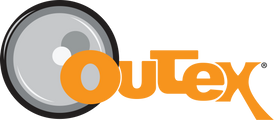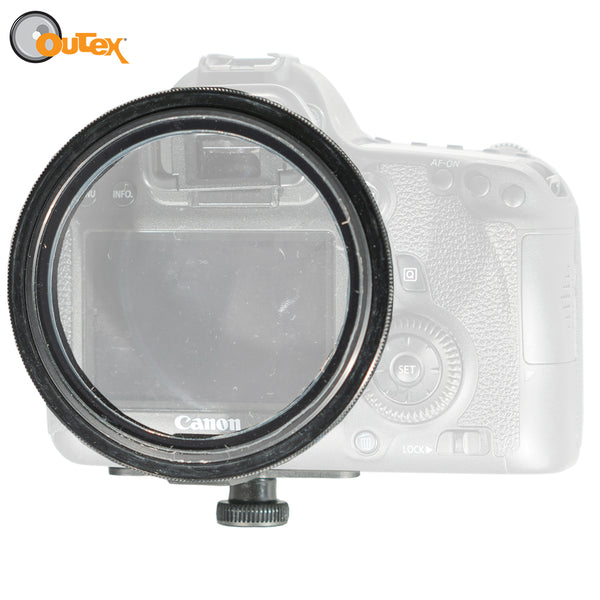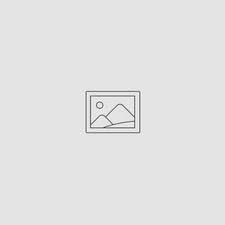Rear Glass Options, Insights, and How They Work
Apr 15, 2023
Rear Glass Port Options, Insights, and How They Work for your camera
1. Tripod-Mounted Option (Default)
Advantage summary:
- Universal fit works for virtually any camera (DSLR, Mirrorless, Film, etc.)
- Size and variable positioning enables both viewfinder and LCD visibility, use
- Adjustability grants access to all operational controls, even behind the glass
- Modular design can be used with adjustable short, long brackets, or floating
The tripod-mounted rear glass option has been the Outex default for several years and we believe it's superior in every way. This solution is universal to all camera makes brands and models as long as they have a tripod mount at the base/bottom of the camera, so you can use it with DSLR, Mirrorless, Film, Medium Format, and other cameras. It enables use and visibility of both the camera's viewfinder as well as the LCD screen. It uses a provided adjustable bracket and screw that also allows for a positioning that fits your camera and the position of your LCD screen and viewfinder. We also sell a "Long Bracket" version for larger cameras or for using a battery grip. You can purchase a Long Bracket from our Shop By Parts online store. It's listed under Accessories & Miscellaneous.
This rear glass design allows the user to control positioning, and still grants full visibility as well as access to all of your controls and buttons, regardless of where they are on the camera (even "behind the glass").
Most modern cameras today have viewfinder sensors, that will toggle the display between the viewfinder and LCD. In other words, they sense the user's face next to it and will automatically toggle/switch between them. Our tripod mounted rear glass is also more compatible and accommodating to these new designs and will not interfere with most of them. Even if it does, you can manually adjust it in the camera's settings/menu. Consult your camera's manual.
2. Viewfinder Mounted Option (Older)
The viewfinder-mounted option is available for most standard camera brands, makes, and models such as Canon, Nikon, Sony, and Pentax. We don't make this anymore, but can custom build on demand, and keep some inventory to support our installed-base of customers. It combines an adaptor that slides or threads onto your camera's viewfinder/eyecup and then holds the rear glass (LCD window). Our patented design allows it to pivot/swing back and forth so it can be moved out of the way of your access of buttons, knobs, and functions. And you can use both the viewfinder and LCD screens accordingly. But this older design is camera specific, and not compatible with many new camera models. These parts can be custom ordered in Shop By Parts as well. Contact us if you need help, or just make a note in our order comments field if you prefer this version instead of the default, tripod mounted version.
3. Floating Option
Both versions of the Outex rear glass can be "floated". That just means you don't connect the rear glass to anything other than the Outex cover itself, and let the rear glass "float" around the back for freer, wider "coverage". This option gives you even more freedom of movement for the rear glass if/when needed, and you can move it more freely using your fingers. In addition to the cover holding it somewhat in place, the strap holder that's included in the bundled Pro Kits, will also assist in positioning the rear glass where desired.
All 3 options work well and use depends on personal preference.
The videos and images below showcase both examples for various cameras.
There's no right or wrong solution as it is your personal preference as to which option is best. The kit defaults to the tripod mounted option.
There's no right or wrong solution as it is your personal preference as to which option is best. The kit defaults to the tripod mounted option.




